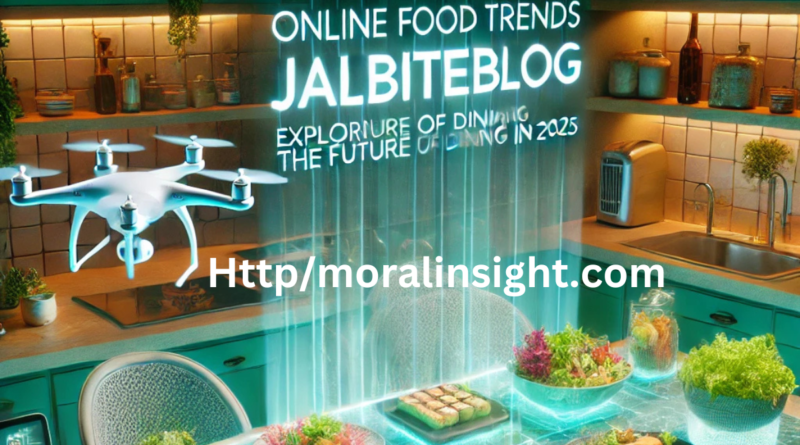Online Food Trends jalbiteblog: Exploring the Future of Dining in 2025
OVERVIEW
Online Food Trends jalbiteblog, Over the years there has been a dramatic shift in how people eat. Modern technology has revolutionized the way we eat from the days of sitting down at restaurants to the plethora of online meal delivery services. But what precisely is influencing our eating habits in the year 2025? Come with me as I explore the most fascinating innovations in internet cuisine that are changing the game in the kitchen.
Changes in Food Consumption Driven by Technology
The days of placing a takeout order by simply phoning your go-to eatery are over. Now more than ever, you may savor a variety of meals without leaving your house, thanks to the proliferation of food delivery apps, phantom kitchens and e-commerce platforms.
How New Technologies Transformed Food Consumption
Modern technology has revolutionized the eating experience, making it more convenient and tailored to each individual. With AI-driven suggestions and subscription-based meal plans, customers can enjoy meals personalized to their tastes at the push of a button.
Popular Online Food Trends
The Rise of Ghost Kitchens
Ghost kitchens, sometimes known as virtual kitchens, have changed the food sector. Without a physical dine-in facility, these restaurants operate entirely for online orders, providing speedier and more cost-effective services.
Plant-Based and Sustainable Options
Sustainability is no longer simply a buzzword. Plant-based food alternatives are dominating internet menus, reflecting customers’ desire for eco-friendly and health-conscious choices.
How Plant-Based Products Dominate Online Menus
From vegan burgers to oat milk, internet platforms are providing a range of plant-based options that appeal to both vegans and flexitarians.
Ready-to-Eat Gourmet Meals
Gone are the days when delivery meant quick food exclusively. Today, ready-to-eat gourmet meals are a current trend, bringing restaurant-quality eating to people’s homes.
Functional Foods and Drinks
Consumers are becoming more conscious of how food effects their health. Functional foods, like immunity-boosting beverages and adaptogenic snacks are increasingly much sought after.
Immunity-Boosting Beverages
From turmeric lattes to kombucha, beverages meant to enhance health are garnering major interest in the online food industry.
Impact of Social Media on Food Choices
Viral Food Challenges
Remember whipped coffee and colorful bagels? Viral food challenges on platforms like TikTok and Instagram have a tremendous effect on culinary trends.
Instagrammable Meals and Aesthetics Presentation important! Instagram-friendly meals with brilliant colors and imaginative plating are influencing buyer choices.
Influencer Partnerships in Food Marketing
Influencers play a vital role in promoting new items to their followers, producing a direct influence on online sales.
The Role of Food Delivery Apps User-Friendly Interfaces
Intuitive and easy-to-use applications have made online food ordering simple.
Subscription-Based Models
Platforms increasingly offer membership programs, providing clients special privileges like free delivery and discounts.
AI and Predictive Analysis in Delivery
AI-driven insights enable food delivery applications to forecast consumer preferences, providing quicker and more customized service.
Personalized Nutrition and AI-Driven Recommendations
Apps Tailored for Dietary Preferences
Whether you’re keto, gluten-free or vegan, applications are now built to cater to certain dietary demands.
Smart Kitchen Integration
Imagine your fridge recommending meals depending on its contents! Smart kitchens are linking with food apps to make meal planning easier.
Regional and Cultural Fusion in Online Food
Exploring Global Cuisines
Online platforms make it possible to experience foods from diverse corners of the globe from Japanese ramen to Mexican tacos.
Revival of Traditional Dishes
While global cuisines are popular, there’s also a rebirth of interest in traditional, regional foods delivered straight to your home.
Challenges in Online Food Trends
Sustainability Concerns
The ease of internet food typically comes at an environmental cost, from superfluous packaging to carbon emissions from delivery.
Data Privacy Issues
With applications gathering user data for tailored services, privacy issues have become a big barrier.
Future Predictions for Online Food Trends
Hyper-Personalization
As AI continues to advance, anticipate even more individualized eating experiences, from meal kits to personalized nutrition regimens.
Integration of AR and VR in Food Shopping
AR and VR technology are likely to alter the way we buy for food online, enabling immersive experiences like virtual supermarket aisles.
Conclusion
The internet food scene is a fascinating combination of innovation and tradition. As we look forward, one thing is clear: technology will continue to alter the way we eat, giving greater options, ease and customization.
FAQs
1.What are ghost kitchens and why are they popular?
Ghost kitchens are delivery-only restaurants that operate without a dine-in area, enabling speedier and more cheap services.
2.How has social media changed food trends?
Social media creates trends via viral challenges, aesthetic displays and influencer endorsements.
3.What are some sustainable food practices in internet dining?
These include employing biodegradable packaging, providing plant-based meals and adopting energy-efficient delivery techniques.
4.How do food delivery apps customize experiences?
By employing AI to evaluate user preferences and giving personalized suggestions and subscription models.
5.What are functional foods and why are they trending?
Functional foods give health advantages beyond simple nutrition, such as increasing immunity or strengthening gastrointestinal health.




Pingback: Teasemoonga: The Ultimate Herbal Tea for Health, Detox and Weig